County Lines exploitation: applying All Our Health
Published 12 February 2021
This guide is part of ‘All Our Health’, a resource which helps health professionals prevent ill health and promote wellbeing as part of their everyday practice. The information below will help front-line health and care professionals use their trusted relationships with patients, families and communities to improve their mental health and wellbeing.
We also recommend important actions that managers and staff holding strategic roles can take.
View the full range of All Our Health topics.
What are County Lines?
The UK government defines County Lines as:
A term used to describe gangs and organised criminal networks involved in exporting illegal drugs into one or more importing areas within the UK, using dedicated mobile phone lines or other form of ‘deal line’.
They are likely to exploit children and vulnerable adults to move and store the drugs and money and they will often use coercion, intimidation, violence (including sexual violence) and weapons.
County Lines exist throughout the UK (Figure 1). It is against the law and a form of child abuse.
County Lines gangs are highly organised criminal networks that use sophisticated, frequently evolving techniques to groom young people and evade capture by the police.
Perpetrators use children and young people to maximise profits and distance themselves from the criminal act of physically dealing drugs (National Crime agency, 2018). Young people do the majority of the work and take the most risk.
Dedicated mobile phone lines or ‘deal lines’ are used to help facilitate County Lines drug deals. Phones are usually cheap, disposable and old-fashioned, because they are changed frequently to avoid detection by the police.
Gangs use the phones to receive orders and contact young people to instruct them where to deliver drugs. This may be to a local dealer or drug user, or a dealer or drug user in another county.
Why focus on County Lines in your professional practice?
Preventing exploitation and protecting vulnerable children is an important public health issue.
Child criminal exploitation is a type of child abuse where children are manipulated and coerced into committing crimes. Criminal exploitation takes many forms. County Lines exploitation, which relates to the supply and movement of drugs, is one of the most recognised.
Health professionals have a role to raise awareness of and identify the risk and protective factors for exploitation throughout a child or adolescent’s development and where necessary intervene to prevent children becoming more vulnerable by reducing risk factors and enhancing protective factors.
‘Children’ is used throughout this document to refer to all children and young people under 18 years.
Figure 1: County Lines drug supply routes
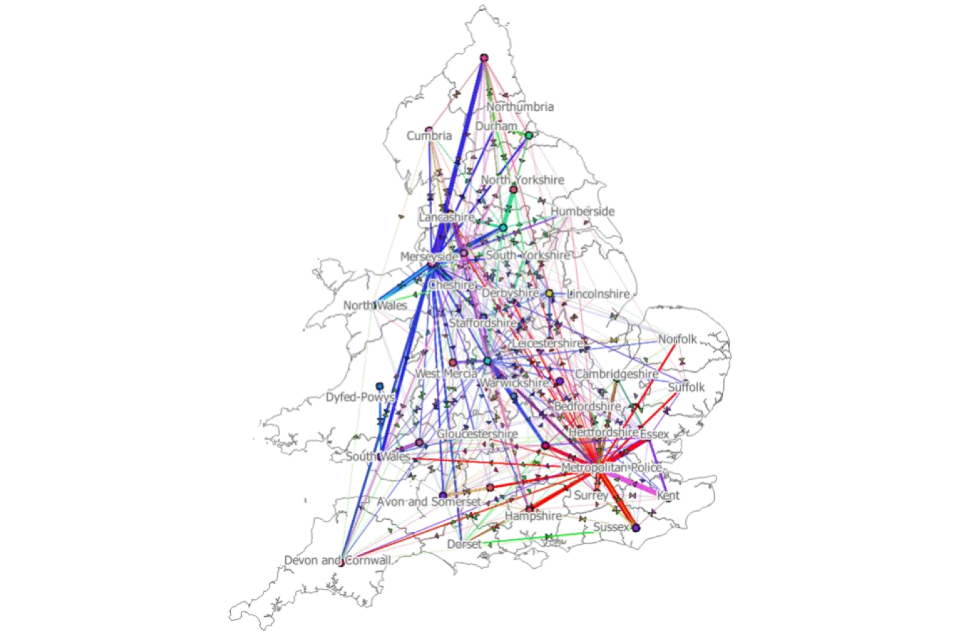
County Lines is financially motivated (National Crime Agency, 2019)
County Lines:
- 1,000 different County Lines operating
- majority originating from London, West Midlands and Merseyside
Profit per line (annually):
- over £800,000
Overall profit (annually):
- over £800,000,000
County Lines incorporates multiple forms of exploitation including coercion, trafficking, child sexual exploitation, gun and knife crime.
Young people involved in County Lines are victims of criminal exploitation and adult gang members can be prosecuted under the Modern Slavery Act 2015.
It is important to recognise the young person as a victim of criminal exploitation even when it appears consensual.
How County Lines work
County Lines operations have evolved and become more sophisticated over time in response to local policing and safeguarding practices.
This has significantly increased the risk of recruitment and exploitation for growing numbers of looked after children who are placed away from their home area or in unregistered, unregulated settings.
Perpetrators may:
- target children and young people of any background, gender or ethnicity, in a range of settings
- use social media to make initial contact with children
- control and coerce through drug debts, grooming and coercion
County Lines involve multiple activities, as shown in Figure 2.
Figure 2: Flowchart showing how County Lines operations work
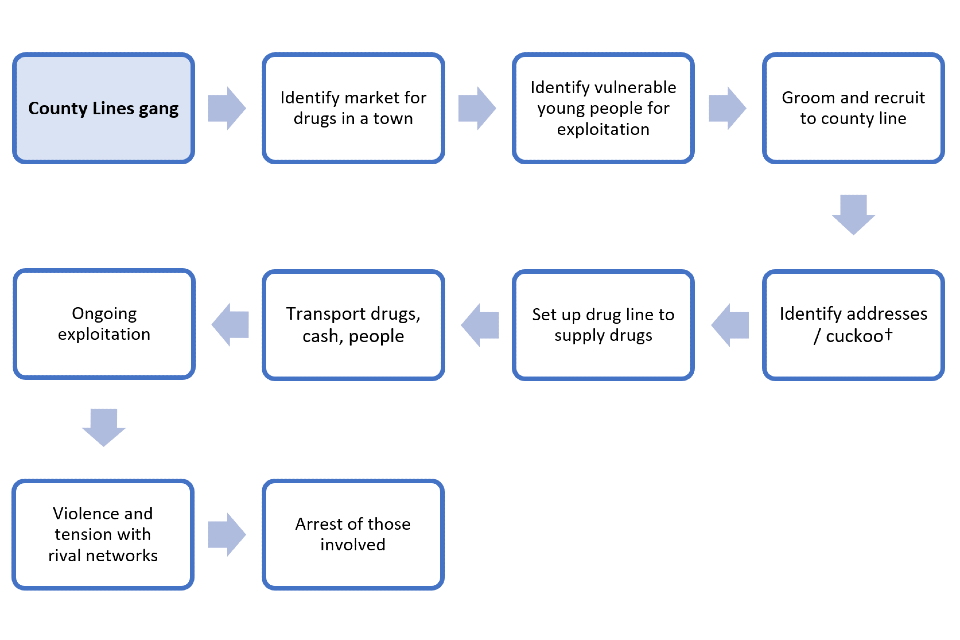
- identify the market for drugs in a town
- identify vulnerable young people for exploitation
- groom and recruit to a county line
- identify addresses/cuckoo†
- set up drug line to supply drugs
- transport drugs, cash, people
- ongoing exploitation
- violence and tension with rival networks
- arrest of those involved
† Cuckoo refers to a drug dealer taking over the home of vulnerable person to use as base to sell or manufacture drugs.
Key data
The exact numbers of children affected by County Lines is unknown as there is currently no systematic data collection (Maxwell et al, 2019).
An estimated 27,000 children in England identified as a gang member (Children’s Commissioner, 2019).
Ninety-one percent of those involved in County Lines are male, however females are underrepresented in the data. Females involvement is less likely to be discovered by services, but we know it does happen, and they may be asked to carry drugs and weapons because they are less likely to be suspected than males (National Crime Agency, 2019). Both females and males may be subject to sexual exploitation linked to County Lines.
Children aged 15 to 17 years are those most commonly identified as victims of County Lines exploitation, although those younger and older are also at risk of exploitation (National Crime Agency, 2019).
During COVID-19, criminal gangs have dressed children as keyworkers (for example, Deliveroo workers) to deliver drugs (Children’s Society, 2020).
Impact of COVID-19
COVID-19 restrictions hamper the ability of front-line agencies to risk-assess for child exploitation and exacerbate the potential for County Line harm to remain hidden (University of Nottingham, 2020).
The National County Lines Coordination Centre has seen a 33% rise in cuckooed addresses due to hotels and other commercial and private rental accommodation closing during this period.
What are the health and wider impacts of County Lines exploitation?
In the absence of a legal definition, and limited guidance or awareness of County Lines, children may be seen as criminals rather than victims (Children’s Society, 2018).
It is the important that the safeguarding needs of children exploited through County Lines are not overlooked.
County Lines is associated with (Children’s Society, 2018):
- physical and sexual violence and abuse, causing physical injuries and emotional harm
- emotional abuse and isolation from peers or social networks, which can lead to self-harm and significant decline in the child’s emotional wellbeing
- negative impact on child’s future outcomes and achievements resulting from persistently missing school in order to undertake criminal activities or spending less time studying at home
- being exposed to 4 or more Adverse Childhood Experiences, leading to increased likelihood of engaging in risky behaviours – for example, high-risk drinking, underage sex and teenage pregnancy, smoking tobacco and cannabis, using heroin or crack cocaine, being a victim of or committing a violent act (Hughes et al, 2017)
- poor mental health and self-harm; Children’s Commissioner (2019) found gang associated children were 77% more likely to have an identified mental health need than other children assessed by children’s services – and twice as likely to have a history of self-harm
- victims of County Lines exploitation can also be subject to the practice of ‘plugging’, where drugs are concealed anally or vaginally for transportation
- potential harms to families of children involved in County Lines – for example, being forced to settle debts
- different forms of vulnerability often overlap, and young people subjected to County Lines exploitation may be subject to sexual exploitation and other forms of criminal exploitation, such as committing theft or violence
- victims of County Lines may also be victims of modern slavery
Modern slavery
Modern slavery involves human trafficking and forced labour. The National Referral Mechanism (NRM) is a framework for identifying and referring potential victims of modern slavery and ensuring they receive the appropriate support. Raising concerns via NRM (Figure 3) requires collaboration with supporting statutory services prior to its submission to the Single Competent Authority.
Figure 3: Raising concerns schematic outline Home Office County Lines guidance (2018)
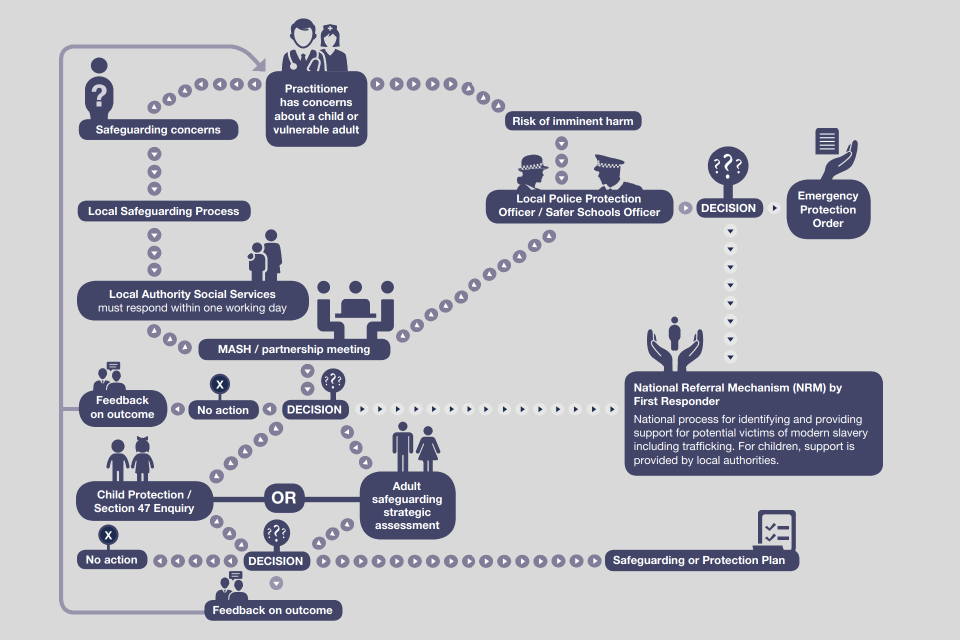
County Lines has contributed to:
- 807% increase in children referred for support by councils in relation to modern slavery (Children’s Society, 2020)
- 401 NRM referrals flagged as County Lines in quarter 3 of 2020, accounting for 16% of all referrals with the majority (82%) for male children (Home Office, 2020)
Figure 4: NRM referrals flagged as county lines, by age group at exploitation and gender
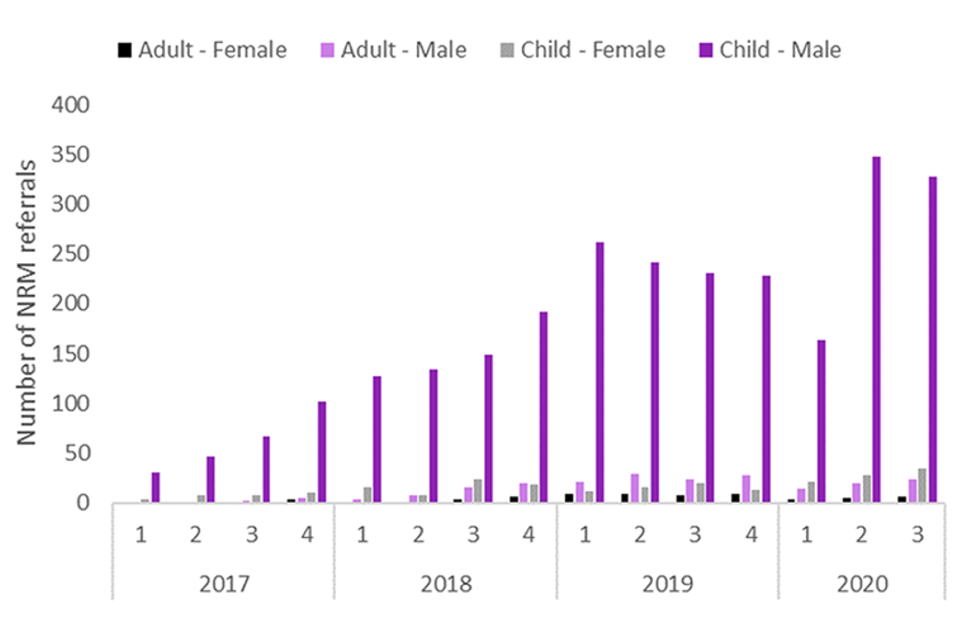
Risk and protective factors
Risk and protective factors may be found at an individual, family or environment level and can change over time depending on factors such as age (Figure 5). These factors are at the core of prevention strategies.
Figure 5: A summary of risk and protective factors, Public Health England, 2019

Resilience is the capacity to bounce back from adversity. Protective factors increase resilience, whereas risk factors increase vulnerability.
Resilient individuals, families and communities are more able to deal with difficulties and adversities than those with less resilience. It is important that resilience is strengthened at both an individual and a societal level.
Indicators of County Lines exploitation
A child’s involvement in County Lines activity often leaves signs that could alert professionals (Home Office, 2018)
Figure 6: Home Office graphic showing the kind of signals that may be shown by someone involved in County Lines activity
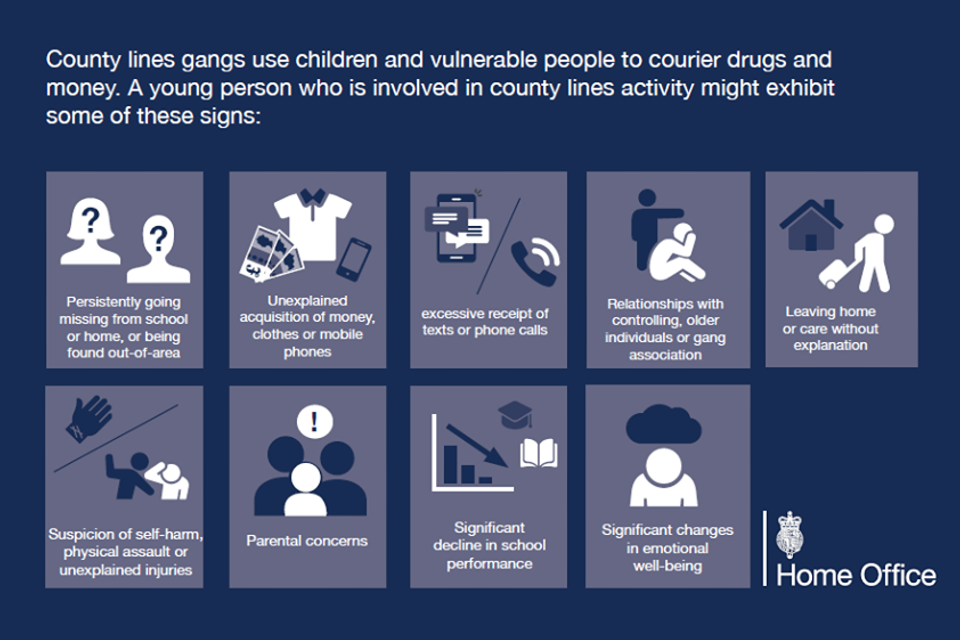
Core principles for health and care professionals
Healthcare professionals and the wider public health workforce should:
- follow local safeguarding policy
- take a public-health approach – identify risk and protective factors for preventing County Lines exploitation, starting before birth and identifying points along the child’s development where a child may be more vulnerable and there may be opportunities to intervene to reduce risk factors and enhance protective factors
- use a whole-family approach to address need, recognising that young people are influenced by a range of environments and people outside of their family, including school and other educational establishments, peer groups, the wider community and, or online
-
understand young people have been exploited and are victims, not criminals, using non-judgemental language that reflects this
- adopt a rights-based approach (United Nations Convention on Rights of the Child, 1989) to protect children from exploitation (article 19, 33, 35, 36)
| Article 19 | Article 33 | Article 35 | Article 36 |
|---|---|---|---|
| Protection from violence, abuse and neglect | Protection from drug abuse | Protection from abduction, sale and trafficking | Protection from any other form of exploitation |
- work in collaboration with partners, including families, schools, public health nurses, police, education, youth service and children’s social care, to safeguard and promote the wellbeing of children and young people
- be aware of the services and specialist provision available locally and nationally to prevent, support and address County Lines exploitation, including:
- local safeguarding leads
- specialist officers within the Regional Organised Crime Unit (ROCU)
- National County Lines Coordination Centre
Taking action
If you’re a front-line health and care professional
When supporting access and engagement, you should:
- identify children most at risk and those already exhibiting signs of involvement with County Lines
- assist young people to gain early help and advice, including adoption of You’re Welcome quality criteria
- ensure young people know how to access help and what help to expect via face-to-face or digital contacts
- be aware of organisations offering specialist support to children who are victims of County Lines exploitation
- build positive relationships with young people and families, listen to what they say, show interest and be professionally curious and non-judgmental, while clearly explaining confidentiality and the need to share information if young people are at risk of harm
For safeguarding and collaboration, you should:
- follow local protocol to undertake holistic assessment using a conceptual model such as the Assessment Framework, enabling the voice of the child
-
follow child safeguarding processes – where there are concerns that a young person is involved in County Lines and a victim of human trafficking, by:
- making a referral to children’s social care
- reporting to police
- supportings completion of National Referral Mechanism, clearly evidencing concerns with factual information
- work collaboratively, communicate effectively and share information appropriately
- act as an advocate for young people where other professionals may be judgmental or reject the need for a child protection response
- explain what is happening to the young people and keep them updated
When building resilience and supporting mental health, you should:
- help young people understand and recognise the signs of peer pressure, bullying, abuse and coercive relationships, and supporting schools in delivery of Relationships and Sex Education (RSE)
- focus on young people’s strengths and future when working with them
- where appropriate support them to access life and social skills development programmes
- raise awareness of the dangers of social media, and its use in reaching out and grooming young people
If you’re a team leader or manager
You should:
- use the local needs assessment to develop service delivery and build relationships across the health, social care, education and criminal justice system
- evaluate local delivery and provide feedback to support learning and improvements to all stakeholders
-
make sure your team has access to:
- the latest guidance and evidence for identifying and supporting young people at risk of exploitation through County Lines
- learning and development opportunities for recognising signs of County Lines exploitation, how to escalate concerns, safeguarding, effective multidisciplinary working and information sharing
- regular safeguarding supervision
If you’re a senior or strategic leader
You should:
-
work with local partners to identify and prevent County Lines exploitation including but not limited to:
- public health teams
- education
- health and social care commissioners and providers
- youth offending teams
- police
- third-sector partners
- local, multi-agency Violence Reduction Units
- create a shared understanding of the vulnerabilities, and the risk and protective factors at a local level
- establish strong multi-agency governance arrangements that make sure a holistic approach to support children and young people at risk of exploitation is taken at a local level and that there are clear pathways and referral mechanisms to access support – such as Multi-Agency Child Exploitation (MACE) or contextual safeguarding protocols
- use the understanding of local needs to target resources to provide prevention and early intervention to reduce risk for children vulnerable to grooming and exploitation
- represent and promote children’s rights in all policies
Understanding local needs
A good understanding of needs and assets within the local area, drawing on Joint Strategic Needs Assessment (JSNA), Child Health Profiles, Public Health Outcomes Framework, School Absence Statistics and local intelligence, is important to developing responses and identifying who might benefit from these approaches. Health professionals are in a good position to engage with their communities and other stakeholders to learn about what is happening locally and develop good knowledge of local services and other community assets.
Specific data sets relating to risk and protective factors and outcomes are available on Fingertips.
Measuring impact
As a healthcare professional, there are a range of reasons why it makes sense to measure your impact and show the value of your contribution. This could be about sharing what has worked well to benefit local people and your colleagues, or to help you with your professional development.
The Introduction to evaluation provides a helpful overview of what evaluation is, when it should be undertaken and different types of evaluation.
There are a number of indicators in the Child health profiles and Public health Outcomes Framework related to County Lines exploitation, including:
- 16 to 17 year olds not in education, employment or training (NEET)
- school absence and exclusion
- first time entrants to the youth justice system
- children in low income households
- children in care
- emotional wellbeing of children in care
- substance and drug misuse
- children with social, emotional and mental health needs
- violent crime (including sexual violence)
Further reading, resources and good practice
Contextual Safeguarding Network: Contextual Safeguarding and County Lines (2019)
County Lines Knowledge Hub site, created for UK policing and its public and select private sector partners
Department for Education: Keeping Children Safe In Education: statutory guidance for schools and colleges (2020)
E-learning for Healthcare: Child Sexual Abuse Awareness and Child Sexual Exploitation
HM Government:
- Tackling sexual abuse strategy 2021 (2021)
- Working Together to Safeguard Children (2018)
- Serious Violence Strategy (2018)
Home Office:
- National Referral Mechanism statistics (2020)
- Child Exploitation Disruption Toolkit
- An analysis of indicators of serious violence Findings from the Millennium Cohort Study and the Environmental Risk (E-Risk) Longitudinal Twin Study Research Report 110 (2019)
- Modern Slavery guidance (2020)
- County Lines Guidance (2018)
HMICFRS: ‘Both sides of the coin’ County Lines review (2020)
National Child Safeguarding Review Panel: Safeguarding children at risk from criminal exploitation (2020)
National County Lines Coordination Centre:
National Crime Agency: Intelligence Assessment – County Lines Drugs Supply, Vulnerability and Harm (2018)
Not in Our Community: Alfie’s Story
Ofsted: Protecting children from criminal exploitation, human trafficking and modern slavery: an addendum (2018)
Public Health England:
- A whole-system multi-agency approach to serious violence prevention: A resource for local system leaders in England (2019)
- Collaborative approaches to preventing offending and re-offending in children (CAPRICORN) (2019)
The Children’s Society:
- Criminal Exploitation: Stages of Recruitment (2018)
- Children & Young People Trafficked for the Purpose of Criminal Exploitation in Relation to County Lines: A Toolkit for Professionals (2018)
UNICEF: The United Nations Convention on the Rights of the Child (1989)
Examples of good practice
NHS England: Recognising & acting on signs of ‘County Lines’ child exploitation: A case study (2018)
Rescue and Response County Lines Project: strategic assessment (2019)
St Giles Trust:
- Evaluation of County Lines – Pilot Project (2018)
- Evaluation of County Lines – Pilot Project update report (2019)
